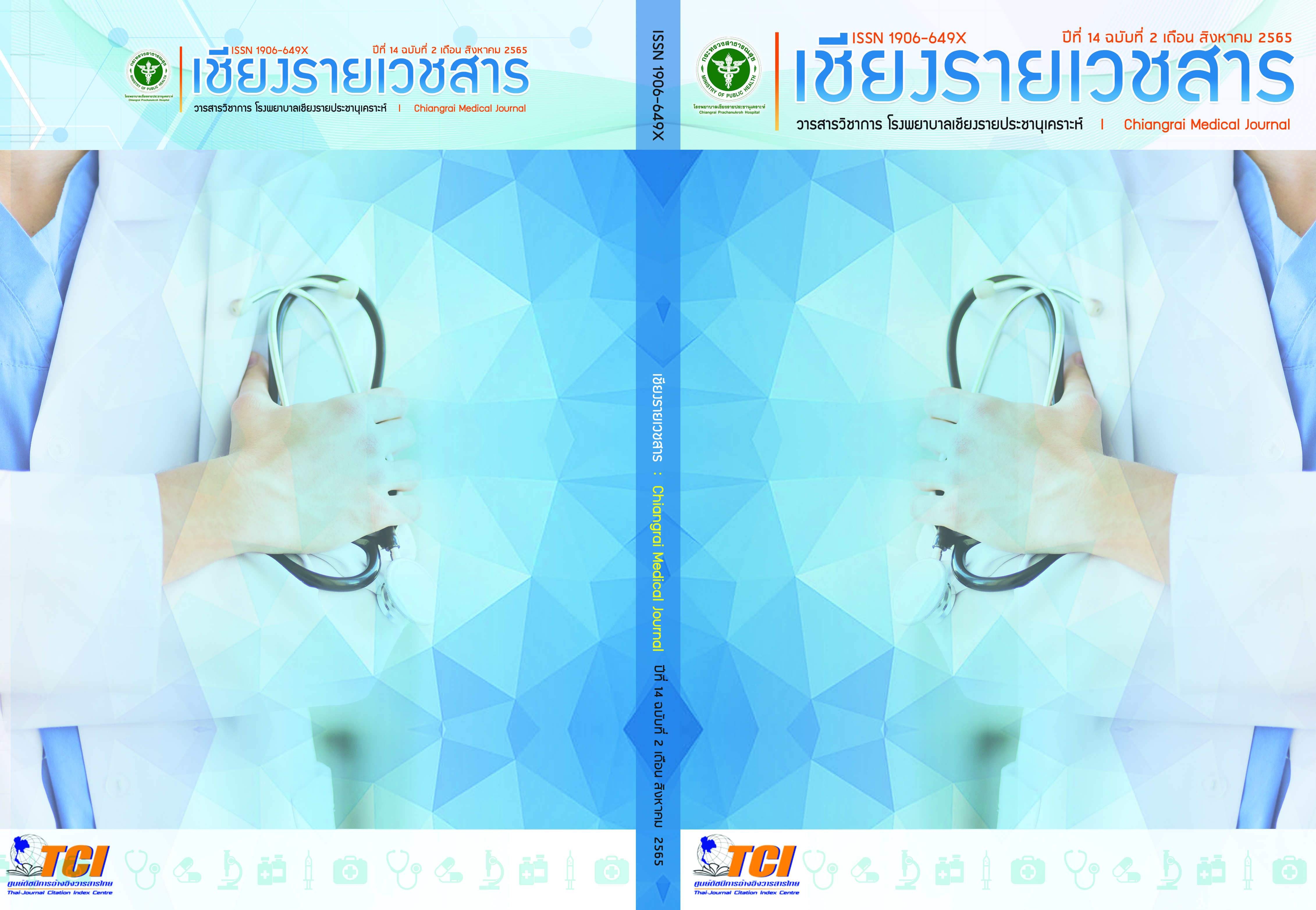ผลของการให้ยาระงับความรู้สึกทางช่องน้ำไขสันหลังร่วมกับมอร์ฟีนในหญิงตั้งครรภ์ที่เข้ารับ การผ่าตัดคลอดในโรงพยาบาลแม่สาย
Main Article Content
บทคัดย่อ
ความเป็นมา : การใช้ยาระงับความความรู้สึกทางช่องน้ำไขสันหลังร่วมกับมอร์ฟีนในการผ่าตัดคลอดสามารถระงับอาการปวดหลังผ่าตัดได้อย่างมีประสิทธิภาพ แต่ก็พบภาวะแทรกซ้อนหลังระงับความรู้สึกมากกว่าผู้ป่วยตั้งครรภ์ที่ได้รับการระงับความรู้สึกวิธีอื่น ดังนั้นจึงได้ทำการศึกษาภาวะแทรกซ้อนของการให้ยาระงับความรู้สึกทางช่องน้ำไขสันหลังร่วมกับมอร์ฟีนในหญิงตั้งครรภ์ที่เข้ารับการผ่าตัดคลอดในโรงพยาบาลแม่สาย
วัตถุประสงค์ : เพื่อศึกษาอัตราความชุกการเกิดภาวะแทรกซ้อนของการให้ยาระงับความรู้สึกทางช่องน้ำไขสันหลังร่วมกับมอร์ฟีนในหญิงตั้งครรภ์ที่เข้ารับการผ่าตัดคลอดในโรงพยาบาลแม่สาย
วิธีการศึกษา : การศึกษาเชิงพรรณนาแบบย้อนหลังของหญิงตั้งครรภ์ที่เข้ารับการผ่าตัดคลอดและได้รับยาระงับความรู้สึกทางช่องน้ำไขสันหลังร่วมกับมอร์ฟีน ในโรงพยาบาลแม่สาย จังหวัดเชียงราย ตั้งแต่ วันที่ 1 ตุลาคม พ.ศ.2562 ถึง 30 กันยายน พ.ศ.2563 วิเคราะห์ผลการศึกษาโดยใช้สถิติเชิงพรรณนาแจกแจงเป็นค่าเฉลี่ยและร้อยละ
ผลการศึกษา : หญิงตั้งครรภ์ที่เข้ารับการผ่าตัดคลอดและได้รับยาระงับความรู้สึกทางช่องไขสันหลังร่วมกับมอร์ฟีนจำนวน 270 ราย พบปัญหาหรือภาวะแทรกซ้อนได้แก่ ความดันโลหิตต่ำ ร้อยละ 77.78 อาการคลื่นไส้ อาเจียน ร้อยละ 27.41 อาการหนาวสั่น ร้อยละ 11.48 และไม่พบอาการปวดศีรษะหลังฉีดยาเข้าน้ำไขสันหลัง ภาวะหัวใจเต้นช้าหรือภาวะ high spinal block
สรุปและข้อเสนอแนะ : ความดันโลหิตต่ำเป็นภาวะแทรกซ้อนที่พบมากที่สุดหลังการให้ยาระงับความรู้สึกทางช่องน้ำไขสันหลังส่งผลให้เกิดภาวะเลือดเป็นกรดในทารกและมารดามีภาวะคลื่นไส้ อาเจียน และเวียนศีรษะได้ การดูแลรักษาผู้ป่วยกลุ่มนี้ด้วยการให้สารน้ำทางหลอดเลือดดำที่เพียงพอ จัดท่าผู้ป่วยนอนหงายและเอียงเตียงซ้าย ติดตามสัญญาณชีพ ให้ออกซิเจน และพิจารณาให้ยาตีบหลอดเลือดตามความเหมาะสม จะช่วยป้องกันการเกิดภาวะแทรกซ้อนของมารดาและทารกได้
Article Details

อนุญาตภายใต้เงื่อนไข Creative Commons Attribution-NonCommercial-NoDerivatives 4.0 International License.
เอกสารอ้างอิง
Ye J, Zhang J, Mikolajczyk R, Torloni MR, Gülmezoglu AM, Betran AP. Association between rates of caesarean section and maternal and neonatal mortality in the 21st century: a worldwide population-based ecological study with longitudinal data. BJOG. 2016;123(5):745-53.
Hawkins JL, Chang J, Palmer SK, Gibbs CP, Callaghan WM. Anesthesia-related maternal mortality in the United States: 1979-2002. Obstet Gynecol. 2011;117(1):69-74.
U.S. Food and Drug Administration. FDA Drug Safety Communication: FDA review results in new warnings about using general anesthetics and sedation drugs in young children and pregnant women. Silver Spring (MD): FDA; 2016.
Petropoulos G, Siristatidis C, Salamalekis E, Creatsas G. Spinal and epidural versus general anesthesia for elective cesarean section at term: effect on the acid-base status of the mother and newborn. J Matern Fetal Neonatal Med. 2003;13(4):260-6.
Wallace DH, Leveno KJ, Cunningham FG, Giesecke AH, Shearer VE, Sidawi JE. Randomized comparison of general and regional anesthesia for cesarean delivery in pregnancies complicated by severe preeclampsia. Obstet Gynecol. 1995;86(2):193-9.
Ring L, Landau R, Delgado C. The current role of general anesthesia for cesarean delivery. Curr Anesthesiol Rep. 2021;11(1):18-27.
Oji-Zurmeyer J, Ortner CM, Klein KU, Gries M, Kühn C, Schroffenegger T, et al. National survey of obstetric anaesthesia clinical practices in the republic of Austria. Int J Obstet Anesth. 2019;39:95-8.
Traynor AJ, Aragon M, Ghosh D, Choi RS, Dingmann C, Vu Tran Z, et al. Obstetric anesthesia workforce survey: a 30-year update. Anesth Analg. 2016;122(6):1939-46.
Maronge L, Bogod D. Complications in obstetric anaesthesia. Anaesthesia. 2018;73 Suppl 1:61-6.
Seki H, Shiga T, Mihara T, Hoshijima H, Hosokawa Y, Hyuga S, et al. Effects of intrathecal opioids on cesarean section: a systematic review and Bayesian network meta-analysis of randomized controlled trials. J Anesth. 2021;35(6):911-27.
Hadzic. Neuraxial SpinalAnesthesia Ultrasound Assisted-Regional anesthesia Crash course [internet]. 2021[cited 2021 Feb 03]. Available form: http://www.nysora.com/techniques/neuraxial-and-perineuraxial-techniques/spinal-anesthesia/
Šklebar I, Bujas T, Habek D. Anaesthesia-induced hypotension in obstetrics:prevention and therapy. Acta Clin Croat. 2019;58 Suppl 1:90-5
Macarthur A, Riley ET. Obstetric anesthesia controversies: vasopressor choice for postspinal hypotension during cesarean delivery. Int Anesthesiol Clin. 2007;45(1):115-32
Uerpairojkit K, Anusorntanawat R, Sirisabya A, Chaichalothorn M, Charuluxananan S. Neonatal effects after vasopressor during spinal anesthesia for cesarean section: a multicenter, randomized controlled trial. Int J Obstet Anesth. 2017;32:41-7.
Xu S, Mao M, Zhang S, Qian R, Shen X, Shen J, et al. A randomized double-blind study comparing prophylactic norepinephrine and ephedrine infusion for preventing maternal spinal hypotension during elective cesarean section under spinal anesthesia: A CONSORT-compliant article. Medicine (Baltimore). 2019;98(51):e18311.
Kinsella SM, Carvalho B, Dyer RA, Fernando R, McDonnell N, Mercier FJ, et al. International consensus statement on the management of hypotension with vasopressors during caesarean section under spinal anaesthesia. Anaesthesia. 2018;73(1):71-92.
Wang X, Mao M, Zhang SS, Wang ZH, Xu SQ, Shen XF. Bolus norepinephrine and phenylephrine for maternal hypotension during elective cesarean section with spinal anesthesia: a randomized, double-blinded study. Chin Med J (Engl). 2020;133(5):509-16.
Xu S, Shen X, Liu S, Yang J, Wang X. Efficacy and safety of norepinephrine versus phenylephrine for the management of maternal hypotension during cesarean delivery with spinal anesthesia: A systematic review and meta-analysis. Medicine (Baltimore). 2019;98(5):e14331.
Zhou C, Zhu Y, Bao Z, Wang X, Liu Q. Efficacy of ondansetron for spinal anesthesia during cesarean section: a meta-analysis of randomized trials. J Int Med Res. 2018;46(2):654-62.
Heesen M, Klimek M, Hoeks SE, Rossaint R. Prevention of spinal anesthesia-induced hypotension during cesarean delivery by 5-hydroxytryptamine-3 receptor antagonists: a systematic review and meta-analysis and meta-regression. Anesth Analg. 2016;123(4):977-88.
Subramani Y, Nagappa M, Kumar K, Fochesato LA, Chohan MBY, Zhu YF, et al. Effect of intrathecal lipophilic opioids on the incidence of shivering in women undergoing cesarean delivery after spinal anesthesia: a systematic review and bayesian network meta- analysis of randomized controlled trials. BMC Anesthesiol. 2020;20(1):214.
Gao C, Sun X, Lu L, Liu F, Yuan J. Prevalence of gestational diabetes mellitus in mainland China: a systematic review and meta-analysis. J Diabetes Investig. 2019;10(1):154-62.
Vounzoulaki E, Khunti K, Abner SC, Tan BK, Davies MJ, Gillies CL. Progression to type 2 diabetes in women with a known history of gestational diabetes: systematic review and meta-analysis. BMJ. 2020;369:m1361.
ASA Physical Status Classification System [Internet]. Illinois: American Society of Anesthesiologists; 2020 [updated December 13; cited 2022 August 20]. Available from: https://www.asahq.org/standards-and-guidelines/asa-physical-status-classification-system
The Royal College of Anesthesiologist of Thailand Guidelines[internet]. Spinal Anesthesia. 2019[cited 2019 june 17]. Available form:https://www.rcat.org/_files/ugd/82246c_16805a0ebfb1452c948b08aa291e5e09.pdf
Agrawal A, Asthana V, Sharma JP, Gupta V. Efficacy of lipophilic vs lipophobic opioids in addition to hyperbaric bupivacaine for patients undergoing lower segment caeserean section. Anesth Essays Res. 2016;10(3):420-4.
Fröhlich M, Koga C, Bührer C, Mori C, Yamamoto M, Sakurai K, et al. Differences in rate and medical indication of caesarean section between Germany and Japan. Pediatr Int.
;62(9):1086-93.
Barber EL, Lundsberg LS, Belanger K, Pettker CM, Funai EF, Illuzzi JL. Indications contributing to the increasing cesarean delivery rate. Obstet Gynecol. 2011;118(1):29-38.


